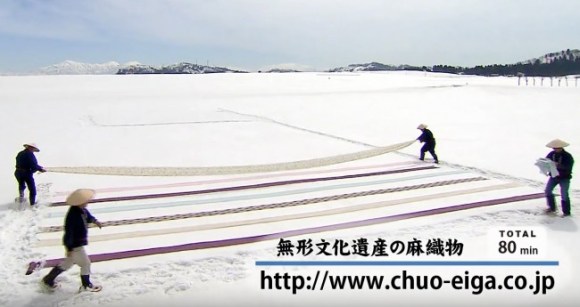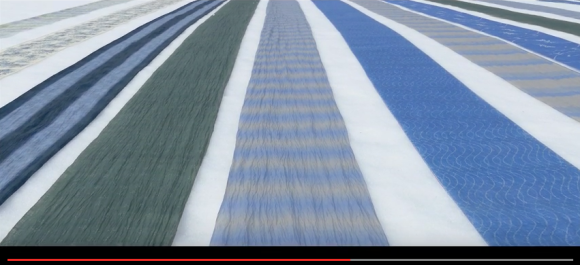
These stunning images show how craftsmen keep their UNESCO Intangible Cultural Heritage alive during the coldest months of the year.
Without snow there is no Ojiya Chijimi. It’s a fact that’s well-known in the Ojiya region of Niigata Prefecture, a place known for its wide, open fields and unusually heavy snowfall. There’s a rich cultural heritage here, and the community is dedicated to keeping it alive, especially when it comes to the local textile tradition of Ojiya Chijimi, which literally translates to “Ojiya Shrinkage”, the art of turning plant fibres into a distinct fabric with the help of sun and snow.
There are many painstaking steps involved in the traditional process, which involves hand-picking stalks of the ramie plant, extracting the fibres, fastening the threads together, and then hand weaving the fabric on a traditional ground loom. Spinning the thread tightly during the weaving process creates a distinctive crease called a “shibo”, which brings a smooth, cool feel to the fabric when worn. Once the cloth has been taken off the loom, it’s then washed in hot water and massaged with the feet. The last step in the process is to take the wet fabric outside, placing it on the snow for ten to twenty days, where it will be lightened by the elements.
The snow increases light reflection from the sun and accelerates ozone production, which helps to lighten the colours of the fabric. During this period, fields in the area look like beautiful outdoor art pieces, with long, colourful bolts of fabric standing out against the pure white snow.
While the tradition has a history which stems back to the 17th century, the fabrics made using this process are still popular today, with the light, cool material often used in summer kimono, cushion covers, and bedding. The craft is a perfect display of harmony between nature and the community, as the fabric born in winter brings its cooling touch to the locals even in the heat of the warm summer months.
To see the hand-woven fabrics being laid out in the snow, check out the captivating videos below.
We have to say, the process is as beautiful as the fashion items made with this cloth. We’re certainly glad the local cloth producers are keeping this UNESCO Intangible Cultural Heritage alive after all these centuries!
And if you love anime as well as fashion, you may be interested to see some of the high-fashion designs that inspired Sailor Moon character outfits. They haven’t been granted UNESCO status yet, but we wouldn’t be surprised if they were one day!
Source: Japaaan
Top Image: Youtube/Chuoeigasha
Screenshots: Youtube/Chuoeigasha, Youtube/PandaStudioNiigata




 The ancient Japanese textile craft made with jagged fingernails
The ancient Japanese textile craft made with jagged fingernails Tokyo fish market breaks New Year auction record as single fish sells for over 5 million yen【Vid】
Tokyo fish market breaks New Year auction record as single fish sells for over 5 million yen【Vid】 Japanese beef bowl chain Sukiya’s 2026 Smile Box lucky bag basically pays for itself
Japanese beef bowl chain Sukiya’s 2026 Smile Box lucky bag basically pays for itself We revisited Sweets Paradise after a decade to see if Japan’s dessert buffet still delivers
We revisited Sweets Paradise after a decade to see if Japan’s dessert buffet still delivers Should you dip your cake in sake? One Japanese brewer says no, but actually yes【 Taste test】
Should you dip your cake in sake? One Japanese brewer says no, but actually yes【 Taste test】 100 years of Japanese women’s hair and makeup trends in less than a minute and a half【Video】
100 years of Japanese women’s hair and makeup trends in less than a minute and a half【Video】 How to find a lost cat: Unique method from Japan proves to be surprisingly effective
How to find a lost cat: Unique method from Japan proves to be surprisingly effective Japanese group to hold fashion show of colostomy bags and other stoma equipment in Paris
Japanese group to hold fashion show of colostomy bags and other stoma equipment in Paris Genius-level otaku figures out a way to take a bath with his favorite anime girls every day【Pics】
Genius-level otaku figures out a way to take a bath with his favorite anime girls every day【Pics】 We found possibly the quietest Japanese-style hotel in Tokyo’s bustling Shinjuku district
We found possibly the quietest Japanese-style hotel in Tokyo’s bustling Shinjuku district Rakuten randomly offers 58 New Year’s osechi feasts in Japan, but did we get a star or a dud?
Rakuten randomly offers 58 New Year’s osechi feasts in Japan, but did we get a star or a dud? Starbucks Japan ready to get Year of the Horse started with adorable drinkware and plushies【Pics】
Starbucks Japan ready to get Year of the Horse started with adorable drinkware and plushies【Pics】 Hayao Miyazaki says Happy New Year to Studio Ghibli fans with new art for Year of the Horse
Hayao Miyazaki says Happy New Year to Studio Ghibli fans with new art for Year of the Horse Cup Noodle tries an authentic Jiro-style ramen, but something’s not quite right
Cup Noodle tries an authentic Jiro-style ramen, but something’s not quite right The best Starbucks Japan Frappuccinos we want to drink again in 2026
The best Starbucks Japan Frappuccinos we want to drink again in 2026 That time Seiji called JASRAC to ask why he didn’t get paid royalties for his song being on TV
That time Seiji called JASRAC to ask why he didn’t get paid royalties for his song being on TV Japan’s oldest largetooth sawfish in captivity back on display in Mie Prefecture
Japan’s oldest largetooth sawfish in captivity back on display in Mie Prefecture Pizza Hut Japan’s hot lucky bags are perfect for a New Year’s pizza party
Pizza Hut Japan’s hot lucky bags are perfect for a New Year’s pizza party 7-Eleven Japan starts new temporary luggage storage service in over 300 branches
7-Eleven Japan starts new temporary luggage storage service in over 300 branches Disillusionment at Tsukiji’s tourist-target prices led us to a great ramen restaurant in Tokyo
Disillusionment at Tsukiji’s tourist-target prices led us to a great ramen restaurant in Tokyo Starbucks teams up with 166-year-old Kyoto doll maker for Year of the Horse decorations【Photos】
Starbucks teams up with 166-year-old Kyoto doll maker for Year of the Horse decorations【Photos】 Tokyo considering law requiring more trash cans following litter increase in heavily touristed area
Tokyo considering law requiring more trash cans following litter increase in heavily touristed area Tokyo’s Tsukiji sushi neighborhood asks tour groups to stay away for the rest of the month
Tokyo’s Tsukiji sushi neighborhood asks tour groups to stay away for the rest of the month Tokyo event lets you travel back in time, for free, to celebrate 100 years since Showa era start
Tokyo event lets you travel back in time, for free, to celebrate 100 years since Showa era start Japan may add Japanese language proficiency, lifestyle classes to permanent foreign resident requirements
Japan may add Japanese language proficiency, lifestyle classes to permanent foreign resident requirements Sanrio theme park in Japan announces plans to expand into a Sanrio resort
Sanrio theme park in Japan announces plans to expand into a Sanrio resort Stamina-destroying “Paralysis Noodles” are Tokyo’s newest over-the-top ramen innovation
Stamina-destroying “Paralysis Noodles” are Tokyo’s newest over-the-top ramen innovation Survey asks foreign tourists what bothered them in Japan, more than half gave same answer
Survey asks foreign tourists what bothered them in Japan, more than half gave same answer Japan’s human washing machines will go on sale to general public, demos to be held in Tokyo
Japan’s human washing machines will go on sale to general public, demos to be held in Tokyo Japan’s deadliest food claims more victims, but why do people keep eating it for New Year’s?
Japan’s deadliest food claims more victims, but why do people keep eating it for New Year’s? We deeply regret going into this tunnel on our walk in the mountains of Japan
We deeply regret going into this tunnel on our walk in the mountains of Japan Studio Ghibli releases Kodama forest spirits from Princess Mononoke to light up your home
Studio Ghibli releases Kodama forest spirits from Princess Mononoke to light up your home Major Japanese hotel chain says reservations via overseas booking sites may not be valid
Major Japanese hotel chain says reservations via overseas booking sites may not be valid Put sesame oil in your coffee? Japanese maker says it’s the best way to start your day【Taste test】
Put sesame oil in your coffee? Japanese maker says it’s the best way to start your day【Taste test】 No more using real katana for tourism activities, Japan’s National Police Agency says
No more using real katana for tourism activities, Japan’s National Police Agency says Starbucks Japan reveals new sakura drinkware collection, inspired by evening cherry blossoms
Starbucks Japan reveals new sakura drinkware collection, inspired by evening cherry blossoms Updated cherry blossom forecast shows extra-long sakura season for Japan this year
Updated cherry blossom forecast shows extra-long sakura season for Japan this year
Leave a Reply